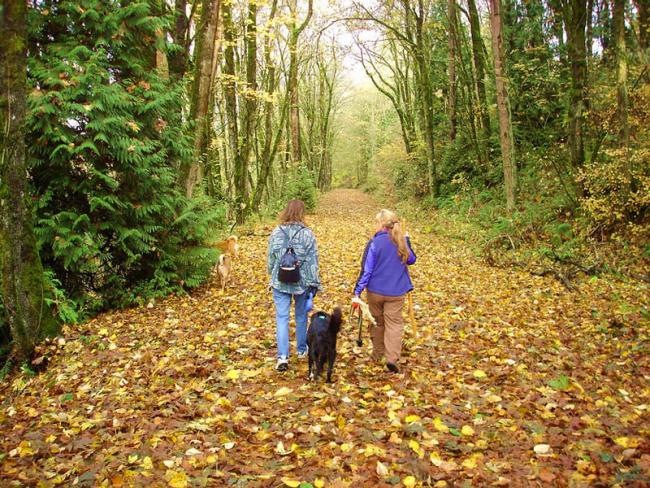The Warmth of Fall
Fri, 12/04/2009
Leaving for work this morning I parked Old Greenie in the driveway while I locked the gate.
Walking back to the van I spot a set of muddy tracks across the asphalt that adjoins the concrete drive. I’d seen them before, last year at this time, large prints mixed with much smaller ones, the hind feet and forepaws of a wild rabbit who I’ve seen around our fences.
It’s a welcome thing to see since Mrs. Anthony and I lost our long lived, beloved rabbit, Grump, a couple of years ago. The van chugs into motion and with the radio tuned quietly to a classical station I ease down the lanes of my neighborhood, the sides of which are heaped with the fallen leaves of maples and alders, ocher and crimson, chocolate and cinnamon, until the grassy medians and peoples yards become reminiscent of the fall season in New England.
The only thing that is out of place is the temperature, which has been unseasonable to be sure. At the Home Depot, I stop to buy some carpenter’s pencils and a new saw blade. At 7:45 in the morning, a young guy passes me wearing sandals and shorts as he walks by the garden rakes and leaf blowers.
It’s a strange contrast, but today he is dressed more appropriately than I am in my boots, jeans and flannel shirt-jac.
I remember, not so long ago, when the weather at this time of year would frost the pumpkins.
Back on the road, driving down a winding hill, a coyote crosses the road in front of me, head high, sniffing the air absent mindedly, as though he too were wondering why it was so warm this late in the year. When the lower angle of the sun to the earth’s tilted axis shortens the days, we expect cool evenings and foggy days here in the northwest, but when the days this far beyond Indian Summer are still this mild (and ski resort owners begin to get antsy) I can’t help wonder if proponents of global warming are on to something.
Mrs. Anthony’s dad, the Famous Russian, is certain that signs like the melting of the polar caps is a natural, cyclical event, and that we don’t realize it because of our limited understanding of geologic time. Exasperated with my questions about the subject, he shouts, ‘SCOTT….the amount of time humans have been on the planet is a BLIP compared to how long the earth has existed… how can we know ALL of the weather patterns that have come and gone.’
This is not arguable. Even if he were wrong, for me, it would still be unarguable, but also, he is right.
Scientists generally agree that the earth and solar system is around 4.55 billion years old, and one of them, marine geologist Rob Carter from James Cook University in Townsville, Australia says that, to understand climate change, we have to look under the sea. Deep below the ocean floor the earth’s history is layered like the rings of a tree.
Professor Carter claims that over 2.5 million years there has been 50 glacial and interglacial periods. Of the past 400,000 years, the earth had been colder for 90 percent of the time, with briefer warmer periods of about 10,000 years.
"We are in a relatively warm period today," he said. "But 20,000 years ago, it was as cold as it has ever been - that was the peak of the last glaciation."
Carter suggests that the earth is now at the end of a warmer period, and reputable climate-change scientists agree that the climate is going to get colder. The debate is whether it will take tens, hundreds or even thousands of years to occur.
He concludes by saying that world climates have always changed and "always will...the only sensible thing to do about climate change is to prepare for it."
At the jobsite, the clouds are sparse as I unload my gear and before going inside, I take a last look at Mt. Rainier glinting and shouldering the sun.
A nice day, too nice to work indoors, but there’s the rub. Next week, I start an outdoor job and sure as sugar, all bets on the melting of the world will be off and there will be rain, and after that, snow and the cycles will be complete once again.


